Optocardiography: Optical Imaging of Cardiac Physiology
In this webinar, you will learn how to use optical imaging for functional cardiac physiological mapping of transmembrane potential, calcium handling, and metabolism.
-The main aspects covered in the webinar include:
-How to design an effective optocardiography system and select optimal fluorescence probes for your research needs using open source hardware and software.
-Troubleshooting tips for reducing noise and motion artifacts during data acquisition
-Advanced optocardiography: multi-parametric, panoramic and transillumination imaging.
-How to design an effective optocardiography system and select optimal fluorescence probes for your research needs using open source hardware and software.
-Troubleshooting tips for reducing noise and motion artifacts during data acquisition
-Advanced optocardiography: multi-parametric, panoramic and transillumination imaging.
Optocardiography: Optical Imaging of Cardiac Physiology
Optical mapping is a technique that is widely used to study heart rhythm disorders, as it offers a higher spatial and temporal resolution on cardiac tissue over traditional electrical mapping. Join Dr. Igor Efimov as he takes you through the steps involved for designing a real-time physiological imaging system as well as a novel, easily-reproducible panoramic imaging system. He will explain the history of optical mapping, basic principles and techniques for obtaining high-quality signals, and useful troubleshooting advice for both the beginner and experienced researcher. The video will take a look at optocardiography of whole mammalian hearts, isolated regions of the heart, and organotypic human cardiac slices. Viewers will also discover RHYTHM, an open-source software for optical mapping data analysis that was developed by the Efimov lab. Finally, the webinar will display representative results of optocardiography studies carried out in different animal models and human heart.
For more information visit: https://bitesizebio.com/webinar/optocardiography-optical-imaging-cardiac-physiology/
Creators and Guests



